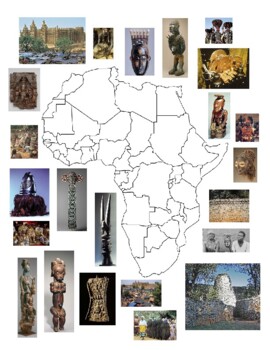6.1 Cultural Contexts of African Art
2 min read•june 18, 2024
Laurie Accede
AP Art History 🖼
34 resourcesSee Units
Overview
Cultural Context
African art has a rich cultural context that is deeply rooted in traditional beliefs, rituals, and daily life. African spirituality also has a profound impact on African art, influencing the themes, styles, and techniques used in various forms of artistic expression. Below are some of the themes found in African art. 👇
- The influence of ancestral worship is present, with some artwork being created in reverence of one's ancestors or to hold their spirits.
- Some art-pieces are depictions of tribal leaders, rulers, and important events to commemorate and reinforce social hierarchies and social status.
- Certain sculptures contain symbolic characteristics that are meant to demonstrate desirable traits in society. This is prevalent in artwork that represents the "ideal woman" (see Bandu Mask).
- Nature and wildlife also holds a strong importance. Similar to indigenous art work in the Americas, African art includes depictions of animals and landscapes that play a significant role in the daily life and beliefs of many African cultures.

Image Courtesy Teachers Pay Teachers
Materials, Processes, and Techniques
A variety of materials were used we also used in African art. These are a few mediums.
- Wood was used for sculptural pieces.
- Clay was used for pottery and other ceramic objects.
- Metal, including brass, iron, and cooper, was used for jewelry and masks.
- Textiles and fibers were used for a variety of woven cloths.
- Stone was often used for carvings, or to create architectural structures.
The Influence of Physical Environment on African Art
The location of African civic centers near agriculture reflects the practical and social importance of food production and resource management to African civilizations. Additionally, many African civilizations held agricultural practices and the relationship to the land in high spiritual and cultural regard. So placing a civic center in close proximity to the land symbolized the importance of this relationship. Moreover, the seasonal climate and weather changes also influenced this decision.
Interactions Across Cultures
Lastly, the trade networks that arise in Africa led to dynamic artistic traditions, as different cultures interacted with one another. As you saw in Unit 3, certain African forms and techniques fused with traditional European styles.
Browse Study Guides By Unit
🗿Unit 1 – Global Prehistoric Art, 30,000-500 BCE
🏛Unit 2 – Ancient Mediterranean Art, 3500-300 BCE
⛪️Unit 3 – Early European and Colonial American Art, 200-1750 CE
⚔️Unit 4 – Later European and American Art, 1750-1980 CE
🌽Unit 5 – Indigenous American Art, 1000 BCE-1980 CE
⚱️Unit 6 – African Art, 1100-1980 CE
🕌Unit 7 – West and Central Asian Art, 500 BCE-1980 CE
🛕Unit 8 – South, East, and Southeast Asian Art, 300 BCE-1980 CE
🐚Unit 9: The Pacific, 700–1980 ce
🏢Unit 10 – Global Contemporary Art, 1980 CE to Present
📚Study Tools

Fiveable
Resources
© 2025 Fiveable Inc. All rights reserved.